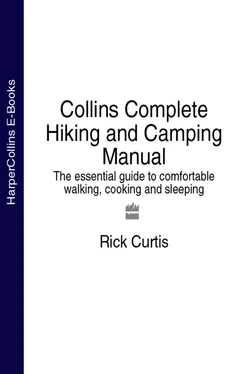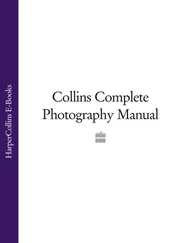TRIP DIFFICULTY RATING
Wouldn’t it be great if you could look in a guidebook and find out how easy or difficult a particular hike would be? Unfortunately there is no commonly used system for rating trail difficulty. Lots of other outdoor sports, like rock climbing and whitewater paddling, have systems for rating the difficulty of a climbing pitch or a whitewater river. These systems are very useful for matching your skill level with the difficulty of the trip.
There are so many factors that can slow down or speed up a hiker that rating the difficulty of a trail is extremely subjective. Take the Appalachian Trail in Pennsylvania: In the southern part of the state, it is on a fairly flat ridge with good trails, then it moves northward and you enter the dreaded “rock zone,” where the trail requires constant rock-hopping for miles that slows down hikers significantly. I look at the following factors and rely on my own hiking experience as a gauge.
Daily mileage
Daily elevation changes—how many feet/meters you go up or down over the course of the day
Steepness of ascent or descent
Trail conditions (smooth, rocky, switchbacks, off trail, etc.)
Amount of weight the person is carrying, as a percentage of their body weight. (See “ The Backpack,”.)
If you are over 8,000 feet (2,438 meters), consider the effect of reduced oxygen and acclimatization on hiking pace. (See “ Altitude Illnesses,”.)
PLANNING A ROUTE
GUIDEBOOKS
I like to start with guidebooks when planning a trip. Since the maps that you would typically take on a trip are pretty specific (and buying lots of maps can get expensive), it’s best to focus on the general area that you are interested in first, and a good guidebook is indispensable. Most guidebooks will give you an overview of the area and some basic maps, so you can get an idea of where to go. A good guidebook will also have specific trails and trips described in detail with mileages, elevation changes, campsites, places to visit, etc. Since guidebooks are so regionally specific, there are lots of different publishers, and finding guidebooks outside your local area can be difficult. Whenever I travel I make it a habit to stop at local bookstores or outdoor shops to see what local-area guidebooks and maps they have. Here are a few of the larger publishers and sources of information you might check out:
Bradt Travel Guides (www.bradt-travelguides.com)
Cicerone (www.cicerone.co.uk)
HarperCollins (www.collins.co.uk)
Maps International (www.mapsinternational.co.uk)
The Ramblers Association (www.ramblers.org.uk)
Rough Guides (www.roughguides.com)
Once you’ve located a specific area, get some maps and start working out the details of your trip. (See “ Maps and Map Reading,”.)
See “Estimating Travel Times”to determine how long each day’s hike will take. For each day, establish a Time Control Plan that includes your hiking time along with other factors to calculate your total travel time for the day. During the day, monitor your Time Control Plan; you may have to modify the trip if you are not able to keep to your planned schedule.
Use the Trip Logistics Plan ( page) to help document your route and to give to your emergency contact person.
As you plan your route, develop a daily evacuation plan and document it on your Trip Logistics Plan. For each day of the trip, know, in general, where you would go to get help in case of an emergency. Obviously, this information will change all the time, but you should know the area well enough to find nearby roads or towns or other resources in case of a problem.
TRAVEL LOGISTICS
Where is your starting point? Where is your ending point? What type of road or other access is there to the trail?
Is everyone traveling together to get to the trailhead or going separately?
Is this a loop route, or an in-and-out route back to your original starting point (A to A), or a one-way route (A to B)? If A to B, do you need to get back to A to get to your car? Can you do your own shuttle? Or do you need to be picked up at B? Are there taxis or public transportation available?
Once you are out on your trip, keep an accurate daily trip log about where you went, what you saw, how long it took, and so on. This will be a great help in planning your next trip.

TRICKS OF THE TRAIL
Timing is EverythingThere are a lot of environmental factors that can impact your trip route. For example, in mountainous regions like the Rockies, afternoon thunderstorms are very common in the summer. If you are going to travel on exposed ridges or summits, you want to plan your day to leave very early and be back down off exposed areas by the early afternoon. Another mountain issue is snowmelt. The stream crossings in parts of the Alps, Iceland and Norway are legendary. During the summer, as the temperature rises during the day, there is greater snow and ice melt. What can be an easy low-water crossing in the early morning can become a dangerous or impassable current by the afternoon.
CHOOSING CAMPSITES
Trip planning is often done from campsite to campsite. You need to make sure that at the end of the day, you will have a place to set up your tent or tarpaulin that isn’t in the middle of a bog or perched on a steep rockslide. A lot of campsite selection can be done using guidebooks and maps. Select a site that allows your group to set up a good Leave No Trace campsite. (See “ Leave No Trace Hiking and Camping.”) Unfortunately, sometimes you don’t have the information you need to determine a good campsite in advance, and you’ll have to locate a spot as you hike. More than once, I’ve looked at the map contours and thought, “That looks flat; there must be a good campsite there,” only to discover thick underbrush with no open spaces. Here are some general guidelines for campsite selection:
Water Availability Preferably you want a site near a water source; otherwise, you may need to carry in enough water for dinner, breakfast the next day, and possibly the next day’s hike. Is the water source reliable at all times of year? Is it drinkable or must it be treated?
Campsite Space You want a site that provides enough open space for sleeping, cooking, and washing. (These areas do not have to be right next to each other.) In locations like bear country, it is best if you have a campsite with enough space to keep these areas separate (see page).
Campsite Location If you don’t know of a specific campsite, start looking for campsites early in the day. It’s better to stop at a good campsite earlier on and make up the mileage the next day, rather than continue hiking, only to find nothing there—which means either backtracking or continuing to hike on, which could be difficult or even dangerous if it’s getting dark.
Private Land Be sensitive about hiking on private land. In some cases hiking through is permitted but overnight camping is not. If conditions (bad weather, an injured group member) require it, you may decide you need to. If so, recognize that you may be breaking the law and must live with the consequences. Most people are understanding about emergency situations.
Restricted Areas Don’t camp in a restricted area (unless a group member’s safety is at stake). The area is restricted for a reason. If you choose to camp in a restricted area, recognize that you may be subject to tickets, fines, or even arrest. Explain your situation to rangers or other officials and ask for their assistance. Get them involved as allies in helping you in a difficult situation rather than as law-enforcement officials prosecuting you for an offense. In most cases involving safety (like an injury), rangers and wilderness managers are very understanding. They may still require you to move but may be helpful in finding another location.
Читать дальше













